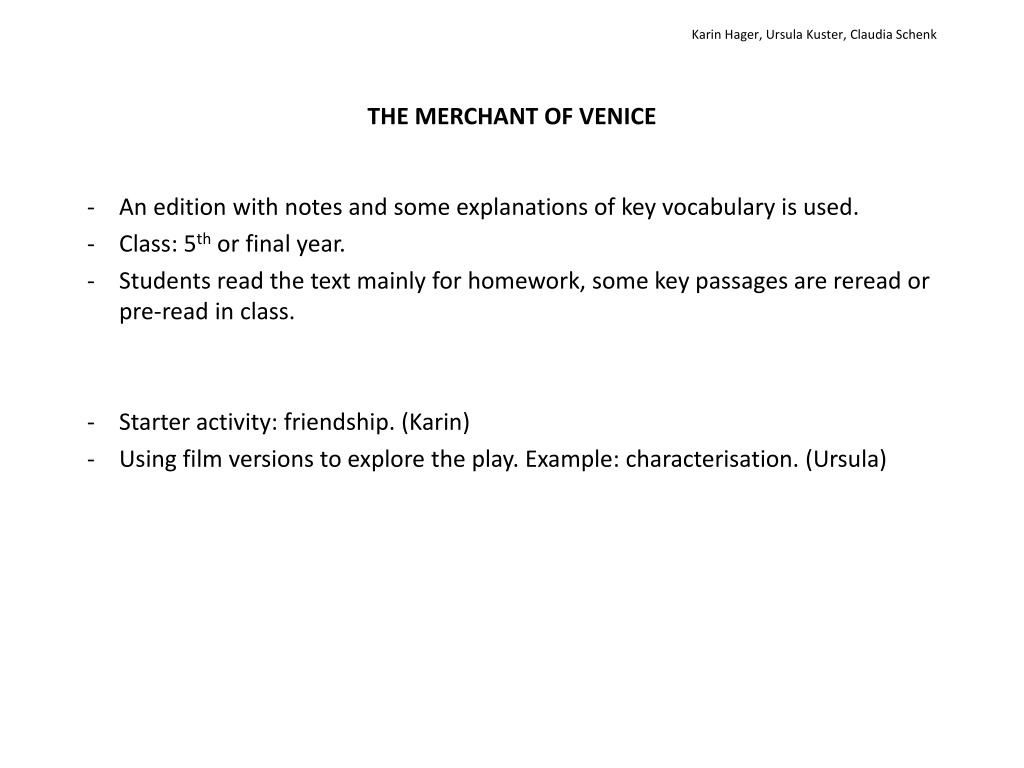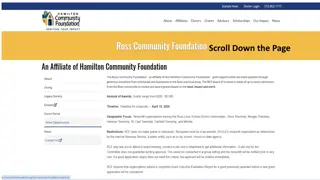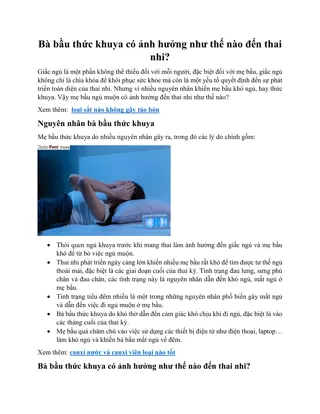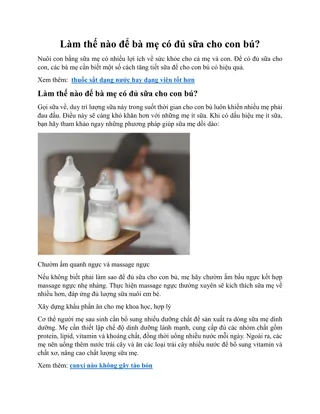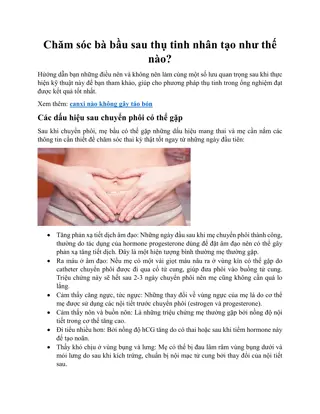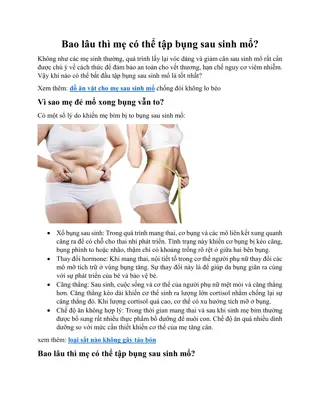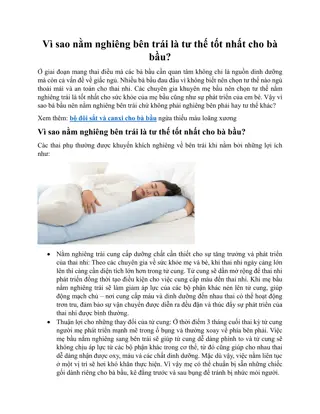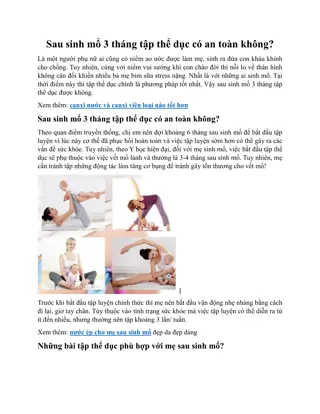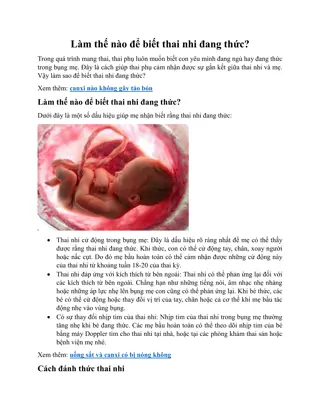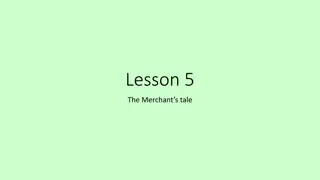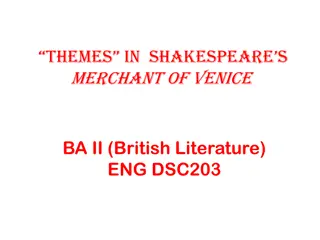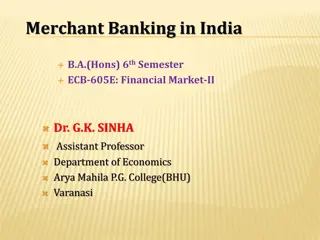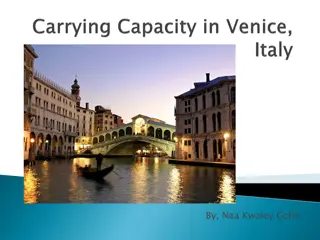THE MERCHANT OF VENICE
In this lesson, students in a 5th-year class engage with Shakespeare's "The Merchant of Venice" through various activities. They explore themes of money, friendship, justice, and mercy, analyze characters like Antonio and Shylock, and delve into the nuances of the plot. The lesson involves group discussions, creative writing tasks, oral argumentation, and genre analysis to deepen the understanding of the play. Through interactive tasks and critical thinking exercises, students develop insights into the text's complexities and interpretive possibilities.
Download Presentation

Please find below an Image/Link to download the presentation.
The content on the website is provided AS IS for your information and personal use only. It may not be sold, licensed, or shared on other websites without obtaining consent from the author.If you encounter any issues during the download, it is possible that the publisher has removed the file from their server.
You are allowed to download the files provided on this website for personal or commercial use, subject to the condition that they are used lawfully. All files are the property of their respective owners.
The content on the website is provided AS IS for your information and personal use only. It may not be sold, licensed, or shared on other websites without obtaining consent from the author.
E N D
Presentation Transcript
Karin Hager, Ursula Kuster, Claudia Schenk THE MERCHANT OF VENICE - - - An edition with notes and some explanations of key vocabulary is used. Class: 5thor final year. Students read the text mainly for homework, some key passages are reread or pre-read in class. - - Starter activity: friendship. (Karin) Using film versions to explore the play. Example: characterisation. (Ursula)
The Merchant of Venice Lesson overview Kind of activity Students task in a nutshell. Act Reducing text to its essence. In small groups, students summarize act I. Introducing major themes. The theme money is explored and linked to other themes. Anticipation, writing. Students guess content of the three love caskets . I (1 L) - - - Evaluation of students guesses. Comparison with real content of the caskets. Link to historical background of the play. Students carry out and present research. II (2 L) - - Writing, creative task. students design and write a missing poster for Jessica. Critical evaluation, interpretation. Antonio and Shylock: good and evil? Why (not)? Language work. Focus on Shakespeare s language. III (2 L) - - - Oral argumentation of points of view. Class discussion of justice and mercy on the basis of given, provocative statements. Writing an essay. Students choose one statement and write an essay about it. Creative writing and roleplay. Students imagine the dialogue of the first encounter between the fianc s after the trial scene, write it down and act it out. IV (3 L) - - - Evaluation of ending. How do students feel about it? Genre discussion. Students find features of comedy and tragedy in the play. Summarizing literary reviews. Illustrates the wide range of different interpretations. Possible follow-up: writing a literary review on another, shorter text. V (2 L +) - - - -
Starter activity: friendship (Karin) Act I - Summary with key points. Small groups (4-6 students) agree on 5 keypoints and write a summary of act I, using their keypoints. Comparison of summaries in class. - Focus on the theme money. Connections between money and other themes are drawn, using a mindmap, which is drawn on the blackboard. In small groups, students explore the single themes and their relation to money in more detail. Then: findings are collected in class and added to the mindmap.
Example: mindmap illustratin connections between money and other themes in act I enemies Shylock - Antonio , Christian values? money friendship Bassanio- Antonio: credit trade Shylock, Antonio, Venice love three caskets,
Act I, continued - Anticipation: what s in the three love-caskets ? Discuss wedding arrangement of the three caskets and its implications. Teacher tells the students that each casket contains a a symbolic item and a short message to the prince who opens it, containing a moral statement on the choice made. Students write a message for each casket and propose a suitable item.
Act II - Follow-up: compare student s messages to the princes to the ones in the play. Compare and discuss. Pre-read third message (lead casket, act III). - Dressed up as a man, Jessica elopes with Lorenzo. Link to conventions of the Elizabethan time. In groups, students do research on the background of the play. They answer questions about Shakespeare s time, Shakespearean theatre or the author and his audience. They use the library and/or the internet and later present their findings to the class.
Act III - Students write a missing poster for Jessica. They study examples from the bbc website and use them as models for their own poster. They search the internet for a suitable picture of a 16thcentury woman. Variation: students translate the character Jessica into modern times and write a missing poster for a modern Jessica. - Shylock seeking revenge and cursing his daughter Shylock and Antonio: who s the good guy, who s the bad guy? Why? - Focus on the language of the play: Students listen to a dialogue excerpt, spoken by actors (f.ex. bbc film version). They try to reproduce the dialogue as closely as possible. Language worksheets: Students match Shakespearean words and phrases with their modern English equivalents, rephrase, find literal and metaphorical meanings, etc. Translation: In pairs, students translate different parts of an emotional dialogue into as modern, young and trendy English as possible. They put the parts together and stage their modern dialogue.
Act IV - The themes justice and mercy are discussed in class. The discussion is based on a reading task, previously set for homework. Students had to read act IV and to decide if they agreed with provocative statements on a worksheet. For example: Friendship is more important than love. It was right of Bassanio and Gratiano to give the rings away. Shylock got what he deserves. A man like him doesn t deserve any mercy. Men act like animals. Women are much more reasonable. - Students choose one of the statements and write an essay about it. They argue by referring to the play and then link their thoughts to modern times. - In groups of four, students imagine the conversation between Bassanio, Gratiano, Portia and Nerissa when they meet again in Belmont and the men have to justify the absence of their rings. They write a dialogue and act it out.
Act V - How do students feel about the ending? Is it a happy ending? Have the characters got what they deserve? - Genre: comedy or tragedy? Students look up definitions and find features of comedy and tragedy in the play. Findings are collected in a table and discussed in class. - Students read different literary reviews on the play and summarize the key arguments. Comparing the key points in class gives the students an idea of the wide range of different approaches to and interpretations of the play. Possible follow-up: students study the structure of literary reviews and write one about a short story. Working with film versions: characterisation (Ursula)
